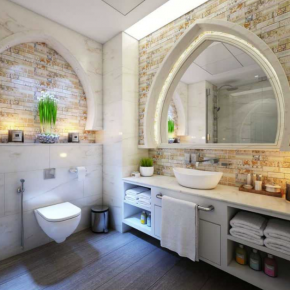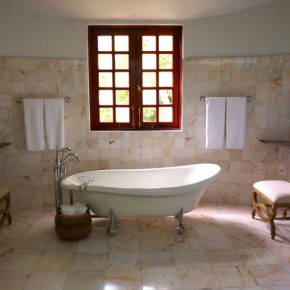
The ultimate underfloor heating guide for your summertime bathroom remodel
The following guest article explores underfloor heating options for bathroom remodels in the summer season.
“IF you are about to complete a bathroom remodel during the summer months, it’s quite likely you may overlook the idea of installing underfloor heating. It’s likely you will find it hard to envisage those cold winter months and what it feels like to step out of the shower onto a freezing cold floor. And if you are pondering this on a particularly balmy day, you may even love the idea of a cold floor!
Just because it’s warm outside it doesn’t mean you should rule out underfloor heating in your renovation plans. Let’s be clear. There really is nothing worse than tip-toeing around a cold tiled floor during the winter.
Underfloor heating in the bathroom is a wonderful luxury during the winter. It’s fabulous to walk on and makes your daily showering and bathing experience a pleasure. And, with the UK’s tendency to inclement weather, underfloor heating can be a blessing all year round.
On a chilly summer morning, underfloor heating is a great way to bring a little warmth to your bathroom and help ease you into the day. No-one wants to put the central heating on during the summer but enjoying the luxury of a warm bathroom floor feels somehow more acceptable.
There are pros and cons when it comes to underfloor heating though, so check out the advantages and disadvantages in our handy guide before you take the plunge and add it to your summertime bathroom renovation plans.
Underfloor heating – facts you need to know
There are two main types of underfloor heating (wet and dry). A wet underfloor heating system uses water to heat the floor, while a dry system uses electricity. Electric underfloor heating systems are the most commonly used system for single-room underfloor heating, such as in the bathroom.
Electric underfloor heating is cheaper and easier to install, but generally has higher running costs than water underfloor heating. Water underfloor heating is a lot more involved and costly to install so is generally considered more in new builds when the system can be factored in at the planning stage.
Electric underfloor heating – the facts
An electric underfloor heating system uses a series of electric wires or heating sheets, which are installed beneath or within the structure of the flooring. This system generally consists of heating mats, insulation boards and a thermostat.
Options for electric underfloor heating include loose-fit wiring (best for small bathroom spaces), electric cable systems or heating mats (great for rolling out in larger bathrooms). Installing electric underfloor heating is much less hassle than a water-based system and electric systems have a slimmer profile. While it is entirely possible to install underfloor heating yourself, it is generally advisable to employ a professional company unless you have specific expertise. A professional can advise what system to use and can give guidance on preparing the floor space, as well as measuring up and installing the system for you.
One of the biggest DIY mistake people make when installing underfloor heating themselves is in not measuring the room correctly before ordering the heating system. Most underfloor heating systems come in set sizes (see Bathroom Discount Centre’s full range here), so be meticulous when taking measurements. According to Which, if you are a confident DIY-er, it is feasible to install electric underfloor heating yourself, but you need a qualified electrician to connect your system to the mains supply and fit a sensor to control the temperature.
The costs of installing electric underfloor heating is around £50-£75 per square metre. For a do-it-yourself job, it may cost as little as £20 per square metre.
Water underfloor heating – the facts
With a water-based system, underfloor heating requires a series of pipes. The pipes are linked to your boiler (or solar panels) and pump hot water around under the floor. Water underfloor heating is expensive to install but has considerably cheaper running costs.
Water underfloor heating is more energy efficient than radiators. This is because the heat emitted from an underfloor system is more evenly distributed within the room and can therefore use water at a lower temperature than radiators.
However, in most cases the costs of installation are practically impossible to recoup through energy savings in the long term. Whole systems cost anything from £2,000 upwards.
Water underfloor heating isn’t suitable for a DIY project so you will need an expert to install this kind of system.
Underfloor heating – the pros
- Comfort. Lovely toasty feet in the winter!
- Suitable underfloor heating can heat your bathroom better than an individual radiator
- Works at a comparatively lower temperature than any radiator so will reduce heating bills
- Brilliant for saving space in small bathrooms as no need for a radiator
- Can be installed under most flooring types, including stone, tiles, wood or even carpet
- Adds value and prestige to your home
Underfloor heating – the cons
- The cost – aargh. Can be expensive to install
- Can be fiddly and difficult to install
- Can take time and cause a major upheaval to install
- Once installed, can take a long time to warm up (definitely requires a timer)
- May restrict the way you arrange your bathroom furnishings once installed
- If there’s not enough room under your floors, you may need to raise the floor level (more expense)
Latest news

4th March 2025
Gilberts Proves How to Balance Cost-Effective Restoration
Hidden talents have been revealed in the renovation of an iconic 1930s art deco building to transform it into a modern entertainment venue – and Gilberts Blackpool ventilation features there…
Posted in Air Conditioning, Articles, Building Industry News, Building Products & Structures, Building Services, Case Studies, Facility Management & Building Services, Heating, Ventilation and Air Conditioning - HVAC, Restoration & Refurbishment, Retrofit & Renovation
4th March 2025
S. Norton Group showcases £20m shredder for metals recycling CEOs
S. Norton Group hosted a tour of its latest £20m investment in state-of-the-art shredder technology for 17 senior leaders in the European metals recycling industry.
Posted in Articles, Building Industry News, Building Products & Structures, Building Services, Case Studies, Facility Management & Building Services, Plant, Equipment and Hire, Posts, Site Preparation, Sustainability & Energy Efficiency, Waste Management & Recycling
28th February 2025
Passivent ventilation solutions are top of the class
Passivent has supplied a combination of Hybrid Plus2 Aircool ventilators and Hybrid Plus Airstract roof ventilation terminals for a new London primary school.
Posted in Air Conditioning, Articles, Building Industry News, Building Products & Structures, Building Services, Case Studies, Ceilings, Facility Management & Building Services, Heating, Ventilation and Air Conditioning - HVAC, Restoration & Refurbishment, Retrofit & Renovation, Roofs, Sustainability & Energy Efficiency, Ventilation, Walls
28th February 2025
Troldtekt: New acoustic liner ensures good acoustics and easy handling
Both a building’s users and its developers have a good reason to get excited about the new Troldtekt Plus 25 panels. This specially developed acoustic panel sets a high standard for both sound absorption and building efficiency.
Posted in Acoustics, Noise & Vibration Control, Articles, Building Industry News, Building Products & Structures, Building Services, Building Systems, Ceilings, Facility Management & Building Services, Floors, Innovations & New Products, Insulation, Interior Design & Construction, Interiors, Restoration & Refurbishment, Retrofit & Renovation, Timber Buildings and Timber Products, Walls
 Sign up:
Sign up: 
